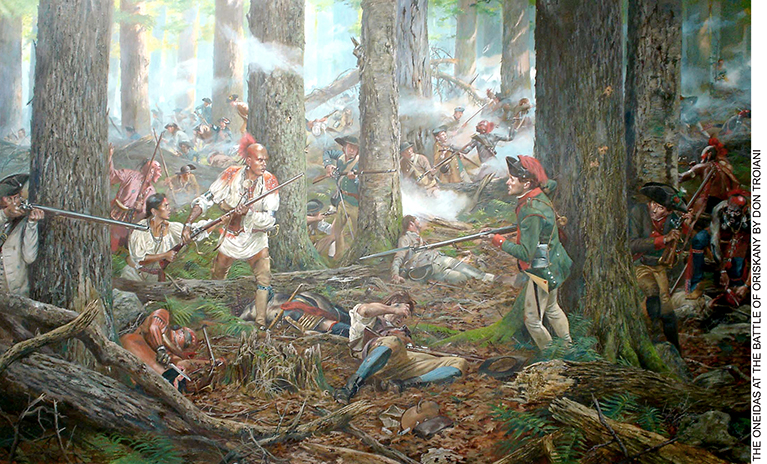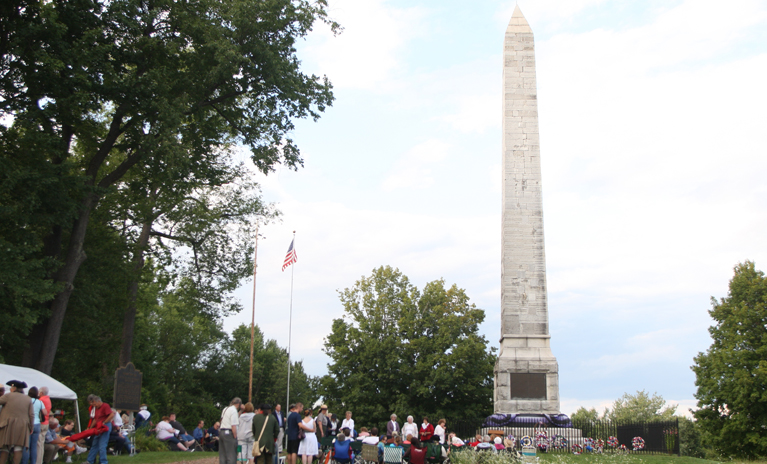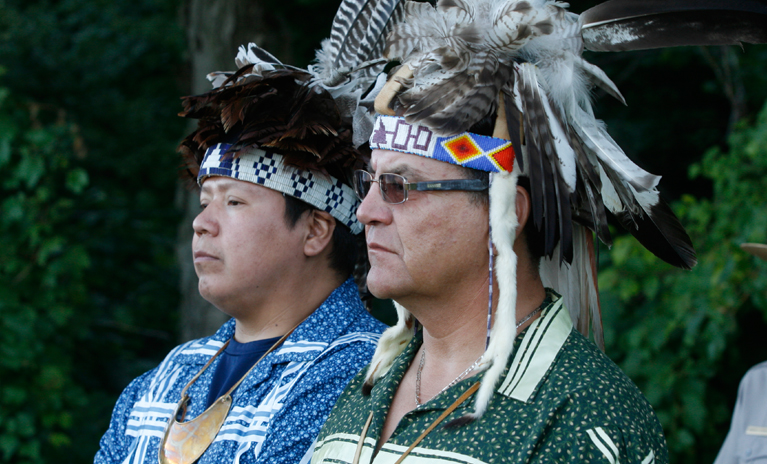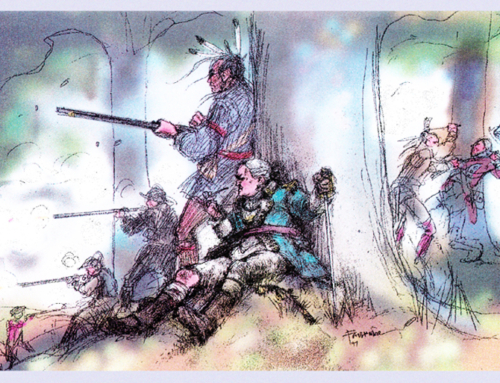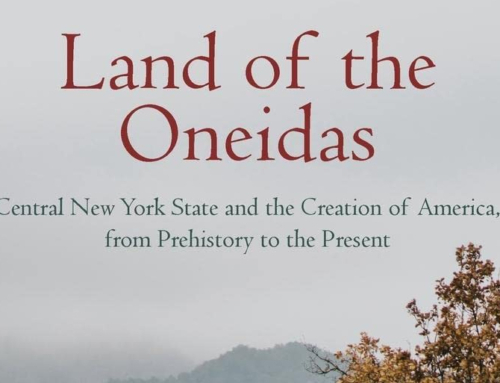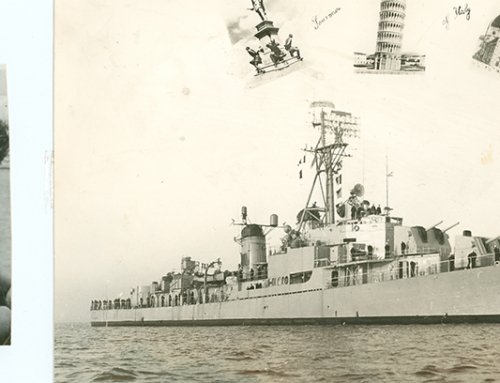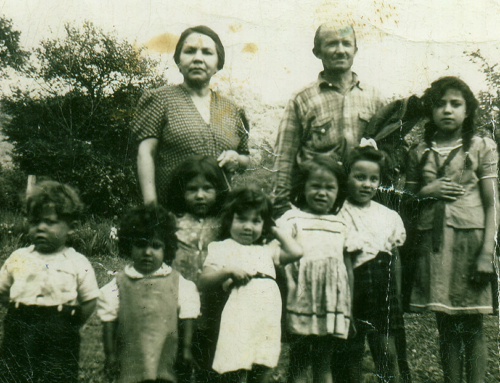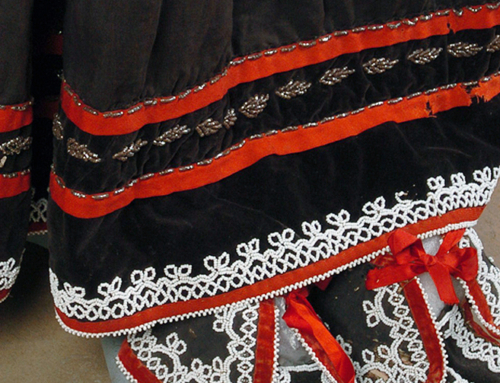The Oneida Indian Nation regularly participates at the annual commemoration ceremony marking the anniversary of the Battle of Oriskany that took place on Aug. 6, 1777. Over the years, books have been written and articles assembled chronicling the bravery of Oneida at Oriskany and other battles during the War for Independence.
Here are a few more testimonials acknowledging the manifest courage and friendship the Oneida offered the colonists during this crucial period for the nascent United States.
The first item is research conducted by the Nation, relaying pertinent information about the battle and its aftermath:
A small battle notable for its carnage, Oriskany was a British victory in spite of the gallantry displayed by the militiamen and Oneidas who fought on for hours after the trap was sprung. The American garrison at the fort exacted some measure of revenge that day in a highly successful raid on the British encampment.
More significantly, the Americans won the campaign. Two weeks after the battle, the British forces besieging Fort Stanwix abandoned camp and fled back the way they had come, their flight precipitated by an American trick involving Oneidas. The commander of the next American relief column sent a messenger to St. Leger’s camp, a man named Hon Yost Schuyler known to the British as a Tory and to the Oneidas as the father of the warrior Blatcop. Hon Yost spread the tale that the Americans were closer and far more numerous than expected. The Loyalist Iroquois, especially the Seneca, were inclined to listen because they were distrustful of the British commander, ill equipped for an extended siege, and dispirited from losses suffered at Oriskany. They fled when Hon Yost’s communication seemed to be confirmed by an Oneida collaborating in the trick. “Upon the retreat of St. Leger, a party of Oneidas hung upon his rear, adding to the panic and speed of his forces (Jones 1851:855; cf. Stone 1851 1:258-60; Graymont 1972:144-5).”
Han Yerry, Han Yerry’s teenage son Jacob Doxtader, and Col. Louis all performed hazardous service at Fort Stanwix (Jones 1851:854-5). Clanis (Cornelius) Kahiktoton was awarded payment “for extraordinary service in going express from Fort Stanwix to German Flatts.” And, soon after Timothy Pickering had documented Oneida losses and services during the Revolution, Kirkland wrote to him (in 1795) with an addendum:
Antony Shonoghlego & Big beard [the Oriska warrior Big Bear, Thaahnyongo] came to me before I left my house with a grievous complaint. That an important piece of service they rendered the United States in the late war had been forgotten in the list they gave in of losses & etc. -viz. Their carrying a letter at the request of the commandant of Fort Stanwix to Genl. Arnold to announce the retiring of the British troops from said fort. To perform this, with any safety, they were obliged to strike off southward of their own village to escape the scouts & reconnoitering parties of the enemy, & went even south of where my dwelling place now is [Clinton], & very narrowly escaped being taken when almost in sight of Genl. Arnold at the German Flatts.
Oriska was attacked by Loyalist Iroquois in revenge for Oneida resistance on the battlefield. Claus’ report of this incident states that the houses, fields, and crops of the Oriskas were utterly destroyed, their cattle killed or carried away (Brodhead 1857 8:725). Nearly a year later, according to Schuyler, the residents of Oriska were still destitute: “The Oneidas of Oriska about fifty in number, including women and children, had all their habitations, stock and provisions destroyed by the Enemy because they had joined General Herkimer…We have ventured to request the commanding officer at Fort Schuyler [Stanwix] to supply them, until the pleasure of Congress shall be signified (Penrose 1981:119-20).”
Centennial Celebration
Oneida also took part during the Oriskany Centennial and were noted in the following two newspaper articles.*
The New York Daily Tribune, Monday, July 23, 1877:
The Rev. Daniel Skenandoa, said to be the grandson of the famous Oneida Chief Skenandoa, has been invited to be present at the Oriskany celebration with a delegation of Oneida Indian. A party of the Oneidas participated in the battle of Oriskany.
And an excerpt from THE ONEIDA INDIANS AT ORISKANY from The Utica Weekly Herald, Tuesday, July 24, 1877:
The invitation committee has invited Rev. Daniel Skenandoa to be present at the Oriskany celebration with a delegation of Oneida Indian. Mr. Skenandoa is, we believe, the grandson of the Oneida chief, Skenandoa, whose bones repose in the Hamilton College cemetery, and who in his lifetime was the next friend of the missionary Samuel Kirkland. To the labors and influence of Kirkland were due the fact that the Oneida tribe of the Six Nations was faithful to the Americans during the revolutionary struggle, and rendered invaluable service as guides and scouts. A small party of Oneidas participated in the battle of Oriskany and Thomas Spencer, the Indian interpreter who warned Herkimer of the approach of St. Leger, was of the Oneida tribe. There will be an historic witness in the presence of the remnant of this once famous tribe at Oriskany.
*News clips thanks to Becky Karst, daughter of Marty Johns (Turtle Clan).


